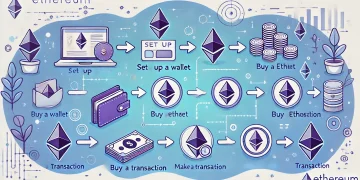Stablecoins, once a niche area within the cryptocurrency space, have gained massive popularity and adoption, prompting growing regulatory scrutiny. Designed to offer stability by being pegged to traditional assets like fiat currencies, stablecoins are now widely used in financial transactions, decentralized finance (DeFi), and cross-border payments. However, the rapid growth and systemic importance of stablecoins have raised concerns among regulators, leading to a global push for formal regulation.
In this article, we will explore why stablecoin regulation has become a focal point for governments, what potential regulations could look like, and how this regulatory shift will impact the broader cryptocurrency market.
Table of Contents
- What Are Stablecoins?
- Types of Stablecoins
- Fiat-Collateralized Stablecoins
- Crypto-Collateralized Stablecoins
- Algorithmic Stablecoins
- The Rise of Stablecoins and Regulatory Concerns
- Growing Market Size and Usage
- Systemic Financial Risks
- Consumer Protection Issues
- Why Are Regulators Pushing for Stablecoin Regulation?
- Financial Stability
- Anti-Money Laundering and Fraud Prevention
- Preventing Market Manipulation
- Global Approaches to Stablecoin Regulation
- United States: The Biden Administration and Congressional Bills
- European Union: The MiCA Framework
- Asia: Japan, Singapore, and South Korea
- Potential Regulatory Frameworks for Stablecoins
- Bank-Like Regulations for Issuers
- Reserve and Liquidity Requirements
- Transparency and Reporting Standards
- Impact of Stablecoin Regulation on the Crypto Market
- Increased Market Trust and Adoption
- Shift Toward Regulatory-Compliant Stablecoins
- Reduced Market Volatility and De-pegging Risks
- Challenges in Regulating Stablecoins
- Defining Stablecoins: Payment Instruments or Securities?
- Jurisdictional Coordination and Cross-Border Challenges
- Balancing Innovation with Oversight
- The Role of Central Bank Digital Currencies (CBDCs) in Stablecoin Regulation
- CBDCs as Competition for Stablecoins
- Coexistence and Integration of Stablecoins with CBDCs
- Key Stablecoins Under Regulatory Scrutiny
- Tether (USDT)
- USD Coin (USDC)
- Binance USD (BUSD)
- DAI
- How Stablecoin Regulation Could Affect DeFi
- Liquidity Pools and DeFi Projects
- KYC and AML Requirements for DeFi Protocols
- The Future of Cross-Border Payments with Stablecoins
- Increased Efficiency and Speed
- Lower Transaction Costs
- How Businesses Should Prepare for Stablecoin Regulation
- FAQs on Stablecoin Regulation
- Conclusion
1. What Are Stablecoins?
Stablecoins are a type of cryptocurrency designed to maintain a stable value by being pegged to traditional financial assets, such as the U.S. dollar, gold, or a basket of currencies. This stability makes them distinct from other cryptocurrencies like Bitcoin or Ethereum, which are known for their price volatility.
By offering price stability and fast, efficient transaction speeds, stablecoins serve as a bridge between traditional finance and the crypto economy, facilitating trading, lending, and payments in both centralized and decentralized environments.
2. Types of Stablecoins
Fiat-Collateralized Stablecoins
Fiat-collateralized stablecoins are backed by reserves of traditional currencies, such as the U.S. dollar or euro. For every unit of a stablecoin like USD Coin (USDC) or Tether (USDT) in circulation, an equivalent amount of fiat currency is held in a reserve. These reserves are typically stored in banks or financial institutions, providing a high level of confidence in the stablecoin’s ability to maintain its peg.
Crypto-Collateralized Stablecoins
Crypto-collateralized stablecoins are backed by other cryptocurrencies, such as Ethereum or Bitcoin, instead of fiat currency. Due to the volatility of cryptocurrencies, these stablecoins are often over-collateralized to ensure stability. DAI, a stablecoin issued by the MakerDAO protocol, is a prominent example. Users must deposit more crypto value than the stablecoin they borrow to hedge against price fluctuations.
Algorithmic Stablecoins
Algorithmic stablecoins do not rely on reserves of fiat or cryptocurrency but instead use algorithms to control their supply. These mechanisms adjust the supply of the stablecoin based on market demand, attempting to maintain a stable price. While innovative, algorithmic stablecoins, such as TerraUSD (UST) before its collapse, have faced significant scrutiny due to the challenges in maintaining their peg during market downturns.
3. The Rise of Stablecoins and Regulatory Concerns
Growing Market Size and Usage
As of 2024, stablecoins account for hundreds of billions of dollars in daily transactions. They are increasingly used for purposes beyond cryptocurrency trading, including cross-border payments, remittances, and even as a hedge against inflation in countries with volatile currencies. Stablecoins like USDT and USDC dominate the market, with a combined market capitalization exceeding $100 billion.
Systemic Financial Risks
The rapid growth of stablecoins has raised concerns among regulators about their potential impact on financial stability. A sudden failure of a major stablecoin could lead to a liquidity crisis, especially given their increasing integration into both traditional and decentralized financial systems. If large amounts of fiat-backed stablecoins are withdrawn from their reserves in a panic, it could trigger a bank run-like event.
Consumer Protection Issues
Stablecoins have also raised issues of consumer protection. In many cases, users may not fully understand how stablecoins maintain their value or the risks involved. Algorithmic stablecoins, in particular, have proven to be vulnerable to market forces that can lead to de-pegging, where the stablecoin loses its 1:1 peg to fiat, resulting in significant losses for holders.
4. Why Are Regulators Pushing for Stablecoin Regulation?
Financial Stability
Stablecoins represent a new kind of financial instrument that straddles the worlds of traditional banking and cryptocurrency. Regulators fear that without proper oversight, stablecoins could pose risks to financial stability, especially if they are widely used as a form of payment or store of value. Ensuring that stablecoins are backed by adequate reserves and meet stringent capital requirements is a key goal of proposed regulations.
Anti-Money Laundering and Fraud Prevention
Cryptocurrencies, including stablecoins, have been criticized for facilitating money laundering and fraud due to the pseudonymous nature of blockchain transactions. Regulators are pushing for stablecoin issuers to comply with Anti-Money Laundering (AML) and Know Your Customer (KYC) rules, ensuring that stablecoins cannot be easily used for illicit activities.
Preventing Market Manipulation
In unregulated markets, stablecoins can potentially be used to manipulate cryptocurrency prices or circumvent capital controls. For instance, concerns have been raised about whether some stablecoins are fully backed by reserves as claimed. Transparency and reporting standards are likely to be key components of any regulatory framework to prevent such manipulation.
5. Global Approaches to Stablecoin Regulation
United States: The Biden Administration and Congressional Bills
In the U.S., regulatory efforts have ramped up significantly. The President’s Working Group on Financial Markets released a report urging Congress to pass legislation that would treat stablecoin issuers similarly to banks. This would involve imposing strict reserve requirements, regular audits, and ensuring that issuers have the necessary liquidity to back their coins. The Stablecoin Transparency Act and other Congressional proposals are aimed at establishing a clear regulatory framework.
European Union: The MiCA Framework
The Markets in Crypto-Assets (MiCA) regulation is the EU’s attempt to create a unified regulatory framework for cryptocurrencies, including stablecoins. MiCA would require stablecoin issuers to meet transparency requirements, maintain adequate reserves, and undergo regular audits. The legislation also seeks to limit the widespread use of non-Euro denominated stablecoins to protect the monetary sovereignty of the Eurozone.
Asia: Japan, Singapore, and South Korea
Asian regulators have also begun establishing rules for stablecoins. Japan has introduced legislation requiring stablecoin issuers to be licensed and supervised by the country’s financial regulators, while Singapore has focused on implementing robust AML/KYC measures. South Korea has taken a proactive approach, requiring stablecoin issuers to adhere to the same financial regulations as traditional payment systems.
6. Potential Regulatory Frameworks for Stablecoins
Bank-Like Regulations for Issuers
One proposal that has gained traction is to regulate stablecoin issuers similarly to banks. This would involve requiring issuers to hold adequate reserves, undergo regular audits, and meet strict capital and liquidity requirements. In this scenario, stablecoin issuers would need to be licensed and supervised by financial regulators.
Reserve and Liquidity Requirements
Stablecoin issuers may also be required to prove that they hold sufficient reserves to back the coins in circulation. These reserves could be held in a mix of fiat currencies, government securities, or other highly liquid assets, ensuring that the stablecoin maintains its peg during periods of market stress.
Transparency and Reporting Standards
To prevent market manipulation and ensure consumer trust, regulators are likely to impose strict transparency requirements on stablecoin issuers. This could include regular audits, public disclosure of reserve holdings, and clear redemption policies.
7. Impact of Stablecoin Regulation on the Crypto Market
Increased Market Trust and Adoption
One of the immediate impacts of regulation would be an increase in trust from both retail and institutional investors. By ensuring that stablecoins are fully backed and transparent, regulators can reduce the risks associated with holding and transacting in stablecoins, potentially leading to wider adoption.
Shift Toward Regulatory-Compliant Stablecoins
Not all stablecoins may survive the regulatory scrutiny. Algorithmic stablecoins, in particular, may face challenges in meeting reserve requirements, leading to a shift toward more compliant fiat-collateralized stablecoins like USDC. Issuers that cannot meet the new standards may be forced out of the market.
Reduced Market Volatility and De-pegging Risks
Stablecoin regulation is expected to reduce the risk of de-pegging events, where the stablecoin loses its 1:1 ratio to the underlying asset. With clear regulations in place, investors will have greater confidence that stablecoins will maintain their value during market downturns, reducing volatility in the broader cryptocurrency market.
8. Challenges in Regulating Stablecoins
Defining Stablecoins: Payment Instruments or Securities?
One of the major challenges regulators face is how to categorize stablecoins. Should they be treated as payment instruments, securities, or commodities? Different regulatory bodies, such as the Securities and Exchange Commission (SEC) and the Commodity Futures Trading Commission (CFTC) in the U.S., may assert jurisdiction depending on how stablecoins are classified.
Jurisdictional Coordination and Cross-Border Challenges
Stablecoins operate on a global scale, and different countries may impose different regulations. This raises challenges for cross-border compliance and coordination. Issuers may need to navigate a patchwork of regulations depending on where their users are located.
Balancing Innovation with Oversight
Regulators face the delicate task of ensuring that stablecoin regulation does not stifle innovation. The crypto industry has thrived in part due to its open and decentralized nature. Overly stringent regulations could slow down development and drive projects into less regulated jurisdictions.
9. The Role of Central Bank Digital Currencies (CBDCs) in Stablecoin Regulation
CBDCs as Competition for Stablecoins
As central banks around the world develop their own digital currencies, known as Central Bank Digital Currencies (CBDCs), stablecoins may face direct competition. Governments may push for the adoption of CBDCs as a safer alternative to privately issued stablecoins, especially for domestic payments.
Coexistence and Integration of Stablecoins with CBDCs
However, there is also potential for stablecoins and CBDCs to coexist. Stablecoins could still play a role in cross-border payments and DeFi applications, while CBDCs could be used for domestic retail payments. The two types of digital currencies could complement each other, particularly if regulatory frameworks are harmonized.
10. Key Stablecoins Under Regulatory Scrutiny
Tether (USDT)
As the largest and most widely used stablecoin, Tether has been at the center of regulatory discussions due to concerns about its reserves. Tether’s history of limited transparency has prompted ongoing investigations and fines from regulatory bodies, making it a key focus for future regulations.
USD Coin (USDC)
USDC, issued by Circle, has gained a reputation for being one of the most transparent stablecoins. USDC’s regular audits and full backing by fiat reserves make it a likely model for future stablecoin regulations.
Binance USD (BUSD)
Binance USD (BUSD), a stablecoin issued by Binance in partnership with Paxos, is another key player. As Binance faces increasing regulatory pressure globally, BUSD will likely be subject to close scrutiny, especially in jurisdictions that are tough on crypto.
DAI
DAI, an algorithmic stablecoin backed by crypto assets, is a unique case in the regulatory landscape. While DAI has been praised for its decentralization, its over-collateralization model could face challenges in meeting reserve requirements under new regulatory frameworks.
11. How Stablecoin Regulation Could Affect DeFi
Liquidity Pools and DeFi Projects
Stablecoins are integral to many DeFi projects, serving as liquidity in decentralized exchanges, lending protocols, and yield farming strategies. Stricter regulation could reduce the availability of certain stablecoins in DeFi, leading to reduced liquidity in DeFi markets and increased borrowing costs.
KYC and AML Requirements for DeFi Protocols
DeFi protocols that rely on stablecoins may also be required to implement Know Your Customer (KYC) and Anti-Money Laundering (AML) processes. This could challenge the decentralized nature of these platforms, as many DeFi projects operate without any centralized control or customer verification.
12. The Future of Cross-Border Payments with Stablecoins
Increased Efficiency and Speed
Stablecoins have already demonstrated their potential to revolutionize cross-border payments by offering faster, cheaper, and more transparent alternatives to traditional payment systems. With proper regulation, stablecoins could become even more widely used for international transactions, reducing reliance on slow and expensive intermediaries like SWIFT.
Lower Transaction Costs
One of the primary benefits of using stablecoins for cross-border payments is the reduction in transaction fees. Unlike traditional banking systems that often charge high fees for international transfers, stablecoins allow for near-instant settlement with minimal costs, making them ideal for remittances and business-to-business (B2B) payments.
13. How Businesses Should Prepare for Stablecoin Regulation
As regulatory frameworks for stablecoins take shape, businesses that use or plan to use stablecoins should start preparing by:
- Monitoring Regulatory Developments: Stay informed about the latest regulatory proposals and how they could impact stablecoin usage.
- Implementing Compliance Protocols: Ensure that your business complies with AML/KYC requirements and other regulations that may apply to stablecoin transactions.
- Exploring Partnerships with Stablecoin Issuers: Consider working with reputable stablecoin issuers that meet regulatory standards and offer transparency about their reserves.
14. FAQs on Stablecoin Regulation
1. Why are stablecoins being regulated?
Regulators are concerned about financial stability, money laundering risks, and consumer protection. Stablecoin regulation aims to ensure that issuers are transparent and fully backed by reserves.
2. How will regulation impact stablecoin users?
Users will benefit from increased transparency and trust in stablecoins. However, some stablecoins may face stricter requirements, potentially limiting their use in certain applications.
3. Are algorithmic stablecoins more at risk under new regulations?
Yes, algorithmic stablecoins, which rely on complex mechanisms to maintain their value, may struggle to meet the reserve requirements that fiat-backed stablecoins can more easily satisfy.
4. Will stablecoin regulation slow down innovation in the crypto space?
While there is concern that regulation could stifle innovation, a clear regulatory framework may also encourage more mainstream adoption by reducing uncertainty.
5. How will stablecoin regulation affect DeFi?
DeFi protocols that rely on stablecoins could face reduced liquidity and higher compliance costs, particularly if KYC/AML rules are enforced on decentralized platforms.
6. What is the difference between stablecoins and CBDCs?
Stablecoins are privately issued and backed by various assets, while CBDCs are digital currencies issued and backed by central banks. Both have potential uses in payments, but CBDCs are considered more reliable by governments.
15. Conclusion
The push for stablecoin regulation marks a critical juncture for the cryptocurrency market. As stablecoins play an increasingly important role in both traditional and decentralized finance, regulators are stepping in to ensure that these digital assets are secure, transparent, and properly backed by reserves. While some fear that regulation may stifle innovation, a clear and standardized regulatory framework could ultimately lead to greater trust, adoption, and stability in the cryptocurrency ecosystem.
For businesses, stablecoin regulation offers both challenges and opportunities. By preparing for regulatory changes and aligning with compliant stablecoin issuers, companies can position themselves to benefit from the next wave of innovation in the digital currency space.




























